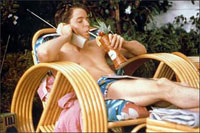Archive
About
Contact
Proposals
Blog
Best Wishes Jason Rhoades
Martyn Reynolds >
-
"Letters from Terra - Ferris Bueller's Day Off"
So let’s speak plainly for a moment. Jason Rhoades is dead. Whatever his metaphysical state, or lack of, one thing is certain: the Jason Rhoades that made art will no longer be making art. So now how do I imagine his work? I wonder if the image has changed.
Jerry Saltz obituary for Rhoades in the Guardian1 questions the viability of viewing Rhoades’ work now,
But there is a sense in which Rhoades art resembles not so much sculpture as dance - once the dancer is gone, it disappears too.
Here Saltz is talking to some degree about the performative nature of the work. Of course there are the logistical challenges of installation, as well as perhaps a certain concern for authenticity in reconstruction. Nevertheless ‘reconstruction’ is inevitable and I wonder what this ‘dance without the dancer’ will feel like.
There is a curious interview with Takashi Murakami in the Journal of Contemporary Art2 in which he states that to be successful an artist must be able to articulate beauty, sexuality and death . He goes on to say that Damien Hirst has negotiated these well, whilst Matthew Barney has failed to articulate death convincingly. He suggests that Barney will fail to garner posthumous recognition because of this. Murakami’s somewhat facetious line here is interesting in that it is mostly a consideration of the factors that will bestow immortality on an artwork. There is an assumption that with the absence of the artist there is a shifting of the focus on the work.
To speak of Rhoades’ work now includes this awareness of an absence, maybe a forced nostalgia, a flatness of intent. What is suggestive is that the dance can continue without the dancer, a kind of ventriloquism on the part of the structures that continue to exist around the work.


I want now to speak briefly about John Hughes’ Ferris Beuller’s Day Off. The film is set in Chicago, where the downtown scenes are shot on location, but Beuller’s school and family home are shot in suburban L.A. This dislocation spanning half the U.S. is traversed by Ferris in Cameron’s dad’s Ferrari. The Ferrari is seriously fucked up at the end of the film. Ferris and Cameron attempt to set the odometer back by putting the car in reverse propped on a jack. The car falls off the jack and the Ferrari smashes through some plate glass and into a ravine. Great scene. The film largely revolves around a series of pranks which Ferris stages and then narrowly pulls off. The main source of tension is the expectation that he will eventually get caught. This never happens. A transference takes place between Ferris and the Ferrari.
And so finally a little bit about motion and linear time. The ineffable linearity of life that death reveals sheds a strange light on the things that remain. And these things move in both directions. The operations of memory and the expected future shape our notion of time in the present. In Kurt Vonnegut’s Slaughterhouse Five he talks about the possibility of living outside time and selecting the present based on innumerable points both ‘past’ and ‘future’. In a way this is a kind of super-materialism. For Vonnegut in this schema an individual’s death is a specific moment, but they continue to live in the past. Their death is just a case of them not doing very well at that point in time.
- Jerry Saltz, Jason Rhoades Obituary, Saturday August 12, 2006, Guardian Unlimited © Guardian Newspapers Limited 2006.
- Mako Wakasa interviews Takashi Murakami, February 24, 2000, Text © copyright 2001, Journal of Contemporary Art, Inc. and the authors.